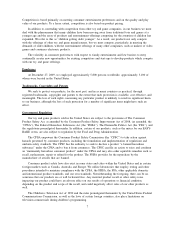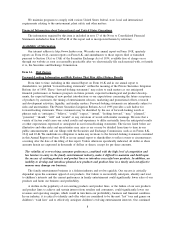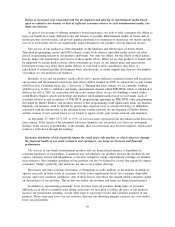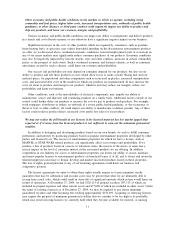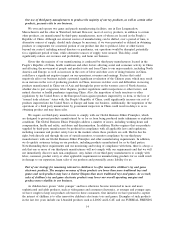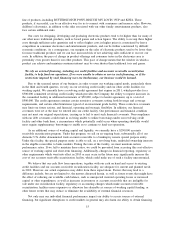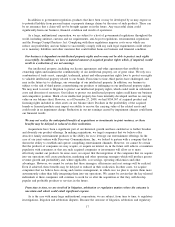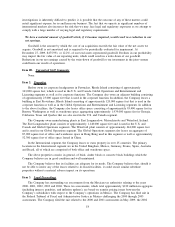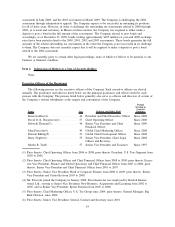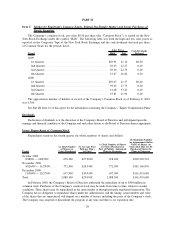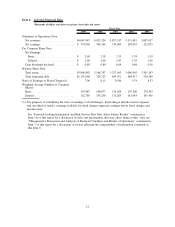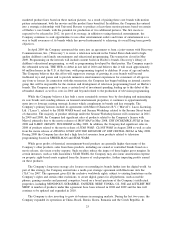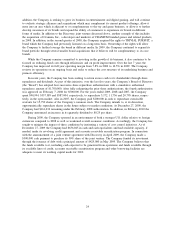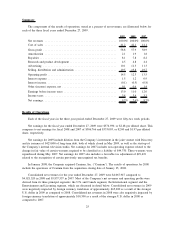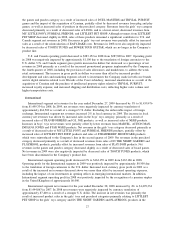Hasbro 2009 Annual Report Download - page 27
Download and view the complete annual report
Please find page 27 of the 2009 Hasbro annual report below. You can navigate through the pages in the report by either clicking on the pages listed below, or by using the keyword search tool below to find specific information within the annual report.In addition to government regulation, products that have been or may be developed by us may expose us
to potential liability from personal injury or property damage claims by the users of such products. There can
be no assurance that a claim will not be brought against us in the future. Any successful claim could
significantly harm our business, financial condition and results of operations.
As a large, multinational corporation, we are subject to a host of governmental regulations throughout the
world, including antitrust, customs and tax requirements, anti-boycott regulations, environmental regulations
and the Foreign Corrupt Practices Act. Complying with these regulations imposes costs on us which can
reduce our profitability and our failure to successfully comply with any such legal requirements could subject
us to monetary liabilities and other sanctions that could further harm our business and financial condition.
Our business is dependent on intellectual property rights and we may not be able to protect such rights
successfully. In addition, we have a material amount of acquired product rights which, if impaired, would
result in a reduction of our net earnings.
Our intellectual property, including our license agreements and other agreements that establish our
ownership rights and maintain the confidentiality of our intellectual property, are of great value. We rely on a
combination of trade secret, copyright, trademark, patent and other proprietary rights laws to protect our rights
to valuable intellectual property related to our brands. From time to time, third parties have challenged, and
may in the future try to challenge, our ownership of our intellectual property. In addition, our business is
subject to the risk of third parties counterfeiting our products or infringing on our intellectual property rights.
We may need to resort to litigation to protect our intellectual property rights, which could result in substantial
costs and diversion of resources. Our failure to protect our intellectual property rights could harm our business
and competitive position. Much of our intellectual property has been internally developed and has no carrying
value on our balance sheet. However, as of December 27, 2009, we had $554,567 of acquired product and
licensing rights included in other assets on our balance sheet. Declines in the profitability of the acquired
brands or licensed products may impact our ability to recover the carrying value of the related assets and
could result in an impairment charge. Reduction in our net earnings caused by impairment charges could harm
our financial results.
We may not realize the anticipated benefits of acquisitions or investments in joint ventures, or those
benefits may be delayed or reduced in their realization.
Acquisitions have been a significant part of our historical growth and have enabled us to further broaden
and diversify our product offerings. In making acquisitions, we target companies that we believe offer
attractive family entertainment products or the ability for us to leverage our entertainment offerings. In the
case of our joint venture with Discovery Communications, Inc., we looked to partner with a company that has
shown the ability to establish and operate compelling entertainment channels. However, we cannot be certain
that the products of companies we may acquire, or acquire an interest in, in the future will achieve or maintain
popularity with consumers or that any such acquired companies or investments will allow us to more
effectively market our products. In some cases, we expect that the integration of the companies that we acquire
into our operations will create production, marketing and other operating synergies which will produce greater
revenue growth and profitability and, where applicable, cost savings, operating efficiencies and other
advantages. However, we cannot be certain that these synergies, efficiencies and cost savings will be realized.
Even if achieved, these benefits may be delayed or reduced in their realization. In other cases, we acquire
companies that we believe have strong and creative management, in which case we plan to operate them more
autonomously rather than fully integrating them into our operations. We cannot be certain that the key talented
individuals at these companies will continue to work for us after the acquisition or that they will develop
popular and profitable products or services in the future.
From time to time, we are involved in litigation, arbitration or regulatory matters where the outcome is
uncertain and which could entail significant expense.
As is the case with many large multinational corporations, we are subject, from time to time, to regulatory
investigations, litigation and arbitration disputes. Because the outcome of litigation, arbitration and regulatory
17


